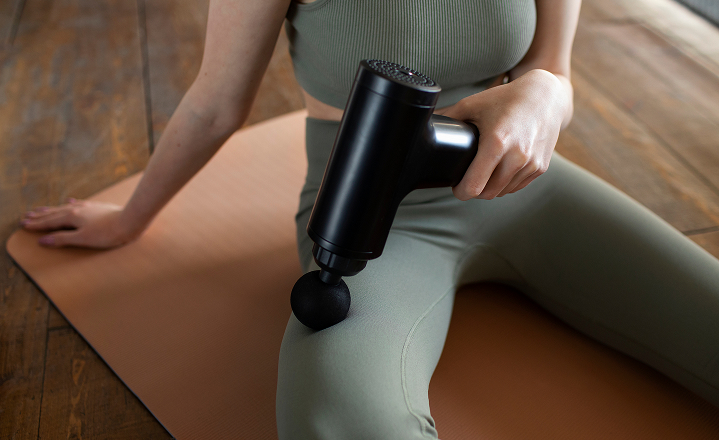BLOG POST
Why Training Harder Wasn't Working (And What Finally Did)
Recovery Tools That Actually Work: Massage Guns,
Compression & Red Light
A few years ago, I started noticing a frustrating pattern.
I’d hit a hard workout, feel great that day, and then spend the next three limping around like I’d been hit by a truck. By the time I finally recovered, it was almost time to repeat the cycle and the consistency I needed to actually get fitter kept slipping through my fingers.
If that sounds familiar, you’re not alone. Most high performers fall into the same trap: we train with intensity, but we recover by accident.
What elite athletes understand and most of us never learn is that your progress isn’t determined by how hard you train. It’s determined by how fast you can recover.
When I finally treated recovery as part of my training instead of a nice-to-have luxury, everything changed. Here’s what worked and why it matters more than you think.

The Wake-Up Call: When Training Harder Stopped Working
At first, I assumed soreness was just part of the deal. “No pain, no gain,” right? But when every leg day left me waddling like a penguin for three days, I realized I wasn’t adapting anymore I was just surviving.
That’s when I stumbled across a simple truth that flipped my approach:
Training breaks you down. Recovery builds you up.
If you can train three times a week without proper recovery, you’ll get about thirty real sessions in three months. Add smart recovery tools of the kind that reduce soreness and speed healing and suddenly you’re hitting fifty sessions in that same window.
Same work ethic. Nearly double the results.
The Massage Gun Experiment
My first recovery upgrade was a massage gun. I was skeptical it looked like a power tool pretending to be fitness equipment but the science was compelling.
Percussive therapy increases blood flow, helps flush out metabolic waste, and activates your body’s relaxation response. Translation: your muscles get nutrients faster and feel less wrecked the next day.
After one tough squat session, I gave it a try. Ten minutes on my legs before bed. The next morning, I braced myself for the usual soreness… and it never came. Not completely gone, but reduced enough that I could train again the following day without hesitation.
That was the first time I understood what real recovery felt like not lazy, not indulgent, just ready.
Compression Therapy: The Secret Weapon of Frequent Flyers
The next discovery came on a red-eye flight. My legs ached after sitting for hours, and a friend handed me a pair of compression sleeves. I thought they were gimmicky until I landed and realized my legs didn’t feel like concrete.
Compression therapy works by gently squeezing your limbs in a way that pushes blood and lymph fluid back toward your heart. It’s like a mechanical assistant for your circulation system. The result: less swelling, less fatigue, and faster recovery between sessions.
These days, I use compression after every heavy leg day or long travel stretch. Sometimes it’s high-tech boots like Normatec; sometimes it’s just tight recovery tights and my legs up the wall while I catch up on calls. Either way, it buys me back training days I used to lose.
The Red Light Experiment
Red light therapy was the wild card. The science is newer; it works by stimulating your cells’ mitochondria, the energy factories that repair tissue and reduce inflammation.
At first, I treated it as an experiment. Fifteen minutes of red light on sore areas at night while reading emails. After a few weeks, I noticed my chronic shoulder ache fading and my post-leg-day fatigue cut nearly in half.
Is it magic? No. But it’s one more lever that turns recovery from “passive waiting” into an active process.
The Shift: Recovery as Strategy
Once I built recovery into my training rhythm massage after workouts, compression after leg days or flights, red light in the evenings I stopped dreading soreness altogether. I could train more often, think more clearly, and actually look forward to each session.
Here’s the bigger realization: recovery tools aren’t luxury gadgets. They’re force multipliers for consistency.
Most people burn out because they treat recovery like an afterthought. The entrepreneurs and athletes who stay in the game for decades? They engineer it.
Because training creates potential but recovery turns that potential into progress.
This week, try one simple change:
After your next workout, spend ten quiet minutes with a massage gun or a light stretch under a red light. Notice how you feel the next day.
That’s the moment you’ll realize recovery isn’t rest. It’s a strategy.



